Monsters
Barghest - Coautl
BARGHEST |
| Barghest Medium Outsider (Evil, Extraplanar, Lawful, Shapechanger) |
Greater Barghest Large Outsider (Evil, Extraplanar, Lawful, Shapechanger) |
||
|---|---|---|---|
| Hit Dice: | 6d8+6 (33 hp) | 9d8+27 (67 hp) | |
| Initiative: | +6 | +6 | |
| Speed: | 30 ft. (6 squares) | 40 ft. (8 squares) | |
| Armor Class: | 18 (+2 Dex, +6 natural), touch 12, flat-footed 16 | 20 (–1 size, +2 Dex, +9 natural), touch 11, flat-footed 18 | |
| Base Attack/Grapple: | +6/+9 | +9/+18 | |
| Attack: | Bite +9 melee (1d6+3)) | Bite +13 melee (1d8+5 | |
| Full Attack: | Bite +9 melee (1d6+3) and 2 claws +4 melee (1d4+1) | Bite +13 melee (1d8+5) and 2 claws +8 melee (1d6+2) | |
| Space/Reach: | 5 ft./5 ft. | 10 ft./5 ft. | |
| Special Attacks: | Spell-like abilities, feed | Spell-like abilities, feed | |
| Special Qualities: | Change shape, damage reduction 5/magic, darkvision 60 ft., scent | Change shape, damage reduction 10/magic, darkvision 60 ft., scent | |
| Saves: | Fort +6, Ref +7, Will +7 | Fort +9, Ref +8, Will +10 | |
| Abilities: | Str 17, Dex 15, Con 13, Int 14, Wis 14, Cha 14 | Str 20, Dex 15, Con 16, Int 18, Wis 18, Cha 18 | |
| Skills: | Bluff +11, Diplomacy +6, Disguise +2 (+4 acting), Hide +11*, Intimidate +13, Jump +12, Listen +11, Move Silently +10, Search +11, Sense Motive +11, Spot +11, Survival +11 (+13 following tracks) | Bluff +16, Climb +17, Concentration +15, Diplomacy +8, Disguise +4 (+6 acting), Hide +10*, Intimidate +18, Jump +21, Listen +16, Move Silently +14, Sense Motive +16, Spot +16 Survival +16 (+18 following tracks), Tumble +16 | |
| Feats: | Combat Reflexes, Improved Initiative, Track | Combat Casting, Combat Reflexes, Improved Initiative, Track | |
| Environment | Bleak Eternity of Gehenna | Bleak Eternity of Gehenna | |
| Organization: | Solitary or pack (3–6) | Solitary or pack (3–6) | |
| Challenge Rating: | 4 | 5 | |
| Treasure: | Double standard | Double standard | |
| Alignment: | Always lawful evil | Always lawful evil | |
| Advancement: | Special (see below) | Special (see below) | |
| Level Adjustment: | — | — |
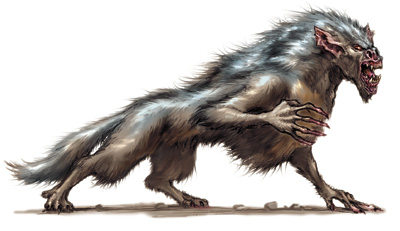
A horrifying wolflike monster with blue-tinged fur, long sharp claws, and a fiendish glint of intelligence in its hateful, glowing eyes darts out of the shadows.
A barghest is a lupine fiend that can take the shape of a wolf or a goblin. In its natural form, it resembles a goblin–wolf hybrid with terrible jaws and sharp claws. Barghests come into the world to feed on blood and souls and thus grow stronger.
As whelps, barghests are nearly indistinguishable from wolves, except for their size and claws. As they grow larger and stronger, their skin darkens to bluishred and eventually becomes blue altogether. A fullgrown barghest, such as the one described here, is about 6 feet long and weighs 180 pounds. A barghest’s eyes glow orange when the creature becomes excited.
Barghests speak Goblin, Worg, and Infernal.
COMBAT
Barghests can claw and bite, no matter what their form, and usually disdain weapons. Though they love killing, they have little stomach for direct combat and attack from ambush whenever possible. Barghests start a combat by using crushing despair and charm monster to keep opponents off balance. They try to stay away from the enemy’s main strength.
A barghest’s natural weapons, as well as any weapons it wields, are treated as evil-aligned and lawful-aligned for the purpose of overcoming damage reduction. Its natural weapons are treated as magic weapons for the purpose of overcoming damage reduction.
Spell-Like Abilities: At will—blink, levitate, misdirection (DC 14), rage (DC 15); 1/day—charm monster (DC 16), crushing despair (DC 16), dimension door. Caster level equals the barghest’s HD. The save DCs are Charisma-based.
Feed (Su): When a barghest slays a humanoid opponent, it can feed on the corpse, devouring both flesh and life force, as a full-round action. Feeding destroys the victim’s body and prevents any form of raising or resurrection that requires part of the corpse. There is a 50% chance that a wish, miracle, or true resurrection spell can restore a devoured victim to life. Check once for each destroyed creature. If the check fails, the creature cannot be brought back to life by mortal magic.
A barghest advances in Hit Dice by consuming corpses in this fashion. For every three suitable corpses a barghest devours, it gains 1 Hit Die, and its Strength, Constitution, and natural armor increase by +1. Its attack bonus and saves improve as normal for an outsider of its Hit Dice, and it gains skill points, feats, and ability score improvements normally.
The barghest only advances by consuming the corpses of creatures whose Hit Dice or levels are equal to or greater than its own current total. A barghest that reaches 9 Hit Dice through feeding immediately becomes a greater barghest upon completion of the act.
Change Shape (Su): A barghest can assume the shape of a goblin or a wolf as a standard action. In goblin form, a barghest cannot use its natural weapons but can wield weapons and wear armor. In wolf form, a barghest loses its claw attacks but retains its bite attack.
Pass Without Trace (Ex): A barghest in wolf form can use pass without trace (as the spell) as a free action.
Skills: *A barghest in wolf form gains a +4 circumstance bonus on Hide checks.
GREATER BARGHEST
A barghest that reaches 9 Hit Dice through feeding becomes a greater barghest. These creatures can change shape into a goblinlike creature of Large size (about 8 feet tall and 400 pounds) or a dire wolf. In goblin form, a greater barghest cannot use its natural weapons but can wield weapons and wear armor. In dire wolf form, a greater barghest loses its claw attacks but retains its bite attack.
A greater barghest can reach a maximum of 18 Hit Dice through feeding.
Spell-Like Abilities: In addition to the spelllike abilities all barghests possess, a greater barghest gains the following abilities. At will—invisibility sphere; 1/day—mass bull’s strength, mass enlarge. Caster level equals the greater barghest’s HD.
Combat
Occasionally, a greater barghest uses a magic two-handed weapon in combat instead of its claws, giving it multiple attacks (attack bonus +13/+8). It can also make one bite attack (attack bonus +8) each round. The save DC against a greater barghest’s spell-like abilities is 14 + spell level.
BASILISK |
| Basilisk Medium Magical Beast |
Abyssal Greater Basilisk Large Outsider (Augmented Magical Beast, Extraplanar) |
|
|---|---|---|
| Hit Dice: | 6d10+12 (45 hp) | 18d10+90 (189 hp) |
| Initiative: | –1 | –1 |
| Speed: | 20 ft. (4 squares) | 20 ft. (4 squares) |
| Armor Class: | 16 (–1 Dex, +7 natural), touch 9, flat-footed 16 | 17 (–1 Dex, –1 size, +9 natural) touch 8, flat-footed 17 |
| Base Attack/Grapple: | +6/+8 | +18/+29 |
| Attack: | Bite +8 melee (1d8+3) | Bite +25 melee (2d8+10) |
| Full Attack: | Bite +8 melee (1d8+3) | Bite +25 melee (2d8+10) |
| Space/Reach: | 5 ft./5 ft. | 10 ft./5 ft. |
| Special Attacks: | Petrifying gaze | Petrifying gaze, Smite Good |
| Special Qualities: | Darkvision 60 ft., low-light vision | Resistance to cold 10 and fire 10, damage reduction 10/magic, darkvision 60 ft., low-light vision, spell resistance 23 |
| Saves: | Fort +9, Ref +4, Will +3 | Fort +18, Ref +12, Will +8 |
| Abilities: | Str 15, Dex 8, Con 15, Int 2, Wis 12, Cha 11 | Str 24, Dex 8, Con 21, Int 3, Wis 10, Cha 15 |
| Skills: | Hide +0*, Listen +7, Spot +7 | Hide +0*, Listen +10, Spot +10 |
| Feats: | Alertness, Blind-Fight, Great Fortitude | Alertness, Blind-Fight, Great Fortitude, Iron Will, Improved Natural Attack (bite), Lightning Reflexes, Weapon Focus (bite) |
| Environment: | Warm deserts | Infinite Layers of the Abyss |
| Organization: | Solitary or colony (3–6) | Solitary or colony (3–6) |
| Challenge Rating: | 5 | 12 |
| Treasure: | None | Standard |
| Alignment: | Always neutral | Always chaotic evil |
| Advancement: | 7–10 HD (Medium); 11–18 HD (Large) | — |
| Level Adjustment: | — | — |
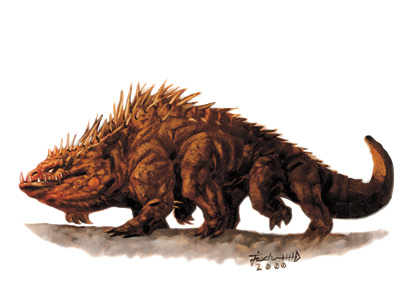
The creature looks like a thick-bodied reptile with eight legs. Rows of bony spines jut from its back, and its eyes glow with an eerie, pale green incandescence.
A basilisk is a reptilian monster that petrifies living creatures with a mere gaze. Surviving a fight with a basilisk requires either careful preparation or considerable good fortune.
Basilisks are found in nearly every climate, and often in underground areas as well. They tend to lair in shallow burrows, caves, or other sheltered areas. The entrance to a basilisk lair is sometimes distinguished by lifelike stone statues or carvings, which are actually creatures that ran afoul of the creature’s gaze. Basilisks are omnivorous and able to consume their petrified victims. They make effective guardians, if one has the magical or monetary resources to capture and contain them.
A basilisk usually has a dull brown body with a yellowish underbelly. Some specimens sport a short, curved horn atop the nose. An adult basilisk’s body grows to about 6 feet long, not including its tail, which can reach an additional length of 5 to 7 feet. The creature weighs about 300 pounds
COMBAT
A basilisk relies on its gaze attack, biting only when opponents come within reach. Though it has eight legs, its slow metabolism renders it relatively sluggish, so it does not expend energy unnecessarily. Intruders who flee a basilisk rather than fight can expect, at best, a halfhearted pursuit. These creatures tend to spend most of their time lying in wait for prey, which includes small mammals, birds, reptiles, and similar creatures.
Petrifying Gaze (Su): Turn to stone permanently, range 30 feet; Fortitude DC 13 negates. The save DC is Charisma-based.
Skills: *The basilisk’s dull coloration and its ability to remain motionless for long periods of time grant it a +4 racial bonus on Hide checks in natural settings.
ABYSSAL GREATER BASILISK
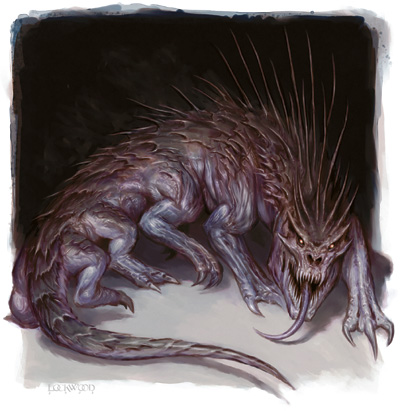
Adventurers are likely to encounter these fiends of the underworld either in their native environment, barren wastelands of the Abyss, or summoned to the employ of some dark sorcerer. Servants of the demon lords make good use of the greater basilisk as guards and escorts.
The save DC for the abyssal greater basilisk’s petrifying gaze (DC 21) is adjusted for its greater Hit Dice and higher Charisma score.
An abyssal greater basilisk’s natural weapons are treated as magic weapons for the purpose of overcoming damage reduction.
Smite Good (Su): Once per day an abyssal greater basilisk can make a normal melee attack to deal an extra 18 points of damage against a good foe.
BEHIR |
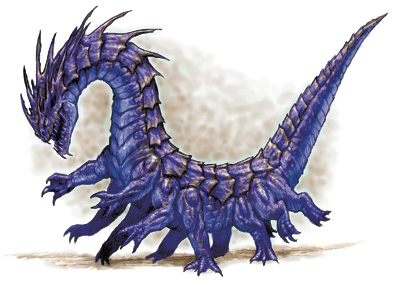 Huge Magical Beast
Hit Dice: 9d10+45 (94 hp)
Initiative: +1
Speed: 40 ft. (8 squares), climb 15 ft.
Armor Class: 20 (–2 size, +1 Dex, +11 natural), touch 9, flat-footed 19
Base Attack/Grapple: +9/+25
Attack: Bite +15 melee (2d4+12)
Full Attack: Bite +15 melee (2d4+12)
Space/Reach: 15 ft./10 ft.
Special Attacks: Breath
weapon, constrict 2d8+8, improved grab, rake 1d4+4, swallow
whole
Special Qualities: Can’t be tripped, darkvision 60 ft., immunity to electricity, low-light vision, scent
Saves: Fort +11, Ref +7, Will +5
Abilities: Str 26, Dex 13, Con 21, Int 7, Wis 14, Cha 12
Skills: Climb +16, Hide +5, Listen +4, Spot +4, Survival +2
Feats: Alertness, Cleave, Power Attack, Track
Environment: Warm hills
Organization: Solitary or pair
Challenge Rating: 8
Treasure: Standard
Alignment: Often neutral
Advancement: 10–13 HD (Huge); 14–27 HD (Gargantuan)
Level Adjustment: —
Huge Magical Beast
Hit Dice: 9d10+45 (94 hp)
Initiative: +1
Speed: 40 ft. (8 squares), climb 15 ft.
Armor Class: 20 (–2 size, +1 Dex, +11 natural), touch 9, flat-footed 19
Base Attack/Grapple: +9/+25
Attack: Bite +15 melee (2d4+12)
Full Attack: Bite +15 melee (2d4+12)
Space/Reach: 15 ft./10 ft.
Special Attacks: Breath
weapon, constrict 2d8+8, improved grab, rake 1d4+4, swallow
whole
Special Qualities: Can’t be tripped, darkvision 60 ft., immunity to electricity, low-light vision, scent
Saves: Fort +11, Ref +7, Will +5
Abilities: Str 26, Dex 13, Con 21, Int 7, Wis 14, Cha 12
Skills: Climb +16, Hide +5, Listen +4, Spot +4, Survival +2
Feats: Alertness, Cleave, Power Attack, Track
Environment: Warm hills
Organization: Solitary or pair
Challenge Rating: 8
Treasure: Standard
Alignment: Often neutral
Advancement: 10–13 HD (Huge); 14–27 HD (Gargantuan)
Level Adjustment: —
At first the creature appears as a huge armored snake, slithering across the ground at great speed. Then, without slowing, it unfolds a dozen legs from its serpentine body and runs forward to strike.
The behir is a serpentine monster that can slither like a snake or use its dozen legs to move with considerable speed.
A behir is about 40 feet long and weighs about 4,000 pounds. It can fold its limbs close to its long, narrow body and slither in snake fashion if it desires. The coloration of behirs ranges from ultramarine to deep blue with bands of gray-brown. The belly is pale blue. The two large horns curving back over the head look dangerous but are actually used for preening the creature’s scales, not for fighting.
Behirs are never friendly with dragonkind and won’t coexist with any type of dragon. If a dragon enters a behir’s territory, the behir does everything it can to drive the dragon out. If the behir fails, it moves off to find a new home. A behir never knowingly enters the territory of a dragon.
Behirs speak Common.
COMBAT
A behir usually bites and grabs its prey first, then either swallows or constricts the opponent. It can employ its claws only against foes caught in its coils. If beset by a large number of foes, it uses its breath weapon.
Breath Weapon (Su): 20-foot line, once every 10 rounds, damage 7d6 electricity, Reflex DC 19 half. The save DC is Constitution-based.
Constrict (Ex): A behir deals 2d8+8 points of damage with a successful grapple check. It can make six rake attacks against a grappled foe as well.
Improved Grab (Ex): To use this ability, a behir must hit a creature of any size with its bite attack. It can then attempt to start a grapple as a free action without provoking an attack of opportunity.
If it wins the grapple check, it it establishes a hold and can attempt to constrict the opponent or swallow the opponent in the following round.
Rake (Ex): Six claws, attack bonus +15 melee, damage 1d4+4.
Swallow Whole (Ex): A behir can try to swallow a grabbed Medium or smaller opponent by making a successful grapple check. A behir that swallows an opponent can use its Cleave feat to bite and grab another opponent.
A swallowed creature takes 2d8+8 points of bludgeoning damage and 8 points of acid damage per round from the behir’s gizzard. A swallowed creature can cut its way out by using a light slashing or piercing weapon to deal 25 points of damage to the gizzard (AC 15). Once the creature exits, muscular action closes the hole; another swallowed opponent must cut its own way out.
A behir’s gizzard can hold 2 Medium, 8 Small, 32 Tiny, or 128 Diminutive or smaller opponents.
Skills: Behirs have a +8 racial bonus on Climb checks and can always choose to take 10 on Climb checks, even if rushed or threatened.
BEHOLDER |
Beholders are the stuff of nightmares. These creatures, also called the “spheres of many eyes” or “eye tyrants,” are deadly adversaries.
Beholders speak their own language and Common.
COMBAT
The primary weapon of both the gauth and the beholder is a series of deadly eye rays.
Eye Rays (Su): Each of a beholder’s small eyes can produce a magical ray once per round as a free action. During a single round, a creature can aim only two eye rays (gauth) or three eye rays (beholder) at targets in any one 90-degree arc (up, forward, backward, left, right, or down). The remaining eyes must aim at targets in other arcs, or not at all. A beholder can tilt and pan its body each round to change which rays it can bring to bear in any given arc.
Each eye's effect resembles a spell (caster level 8th level for a gauth, or 14th for a beholder), but follows the rules for a ray (see Aiming a Spell, page 175 of the Player's Handbook).
All-Around Vision (Ex): Beholders are exceptionally alert and circumspect. Their many eyes give them a +4 racial bonus on Spot and Search checks, and they can’t be flanked.
Flight (Ex): A beholder’s body is naturally buoyant. This buoyancy allows it to fly at a speed of 20 feet. This buoyancy also grants it a permanent feather fall effect (as the spell) with personal range.
GAUTH
Medium Aberration Hit Dice: 6d8+18 (45 hp) Initiative: +6 Speed: 5 ft. (1 square), fly 20 ft. (good) Armor Class: 19 (+2 Dex, +7 natural), touch 12, flat-footed 17 Base Attack/Grapple: +4/+3 Attack: Eye rays +6 ranged touch and bite –2 melee (1d6–1) Full Attack: Eye rays +6 ranged touch and bite –2 melee (1d6–1) Space/Reach: 5 ft./5 ft. Special Attacks: Eye rays, stunning gaze Special Qualities: All-around vision, darkvision 60 ft., flight Saves: Fort +5, Ref +4, Will +9 Abilities: Str 8, Dex 14, Con 16, Int 15, Wis 15, Cha 13 Skills: Hide +11, Knowledge (arcana) +11, Listen +4, Search +15, Spot +17, Survival +2 (+4 following tracks) Feats: AlertnessB, Flyby Attack, Improved Initiative, Iron Will Environment: Cold hills Organization: Solitary, pair, or cluster (3–6) Challenge Rating: 6 Treasure: Standard Alignment: Usually lawful evil Advancement: 7–12 HD (Medium); 13–18 HD (Large) Level Adjustment: -The gauth, sometimes known as the lesser beholder, is a 4-foot wide orb dominated by a central eye. Six smaller eyes on stalks sprout from the top of its body. It is a rapacious and tyrannical creature that seeks to exact tribute from anything weaker than itself, and often attacks adventurers simply to acquire their wealth.
COMBAT
Eye Rays (Su): Each of a gauth’s six eye rays resembles a spell cast by an 8th-level caster. Each eye ray has a range of 100 feet and a save DC of 14. The save DCs are Charisma-based. The six eye rays include:
Sleep: This works like the spell, except that it affects one creature with any number of Hit Dice (Will negates). Gauths like to use this ray against warriors and other physically powerful creatures.
Inflict Moderate Wounds: This works like the spell, causing 2d8+8 points of damage (Will half ).
Dispel Magic: This works like the targeted dispel function of the spell. The gauth’s dispel check is 1d20+8.
Scorching Ray: This works like the spell, dealing 4d6 points of fire damage (no save). A gauth creates only one fiery ray per use of this ability.
Paralysis: The target must succeed on a Fortitude save or be paralyzed for 2d10 minutes.
Exhaustion: This works like the spell ray of exhaustion (no save).
Stunning Gaze (Su): Stun for 1 round, 30 feet, Will DC 14 negates. The save DC is Charisma-based. Any creature meeting the gaze of the gauth’s central eye is subject to its stunning gaze attack. Since the gauth can use its eye-rays as a free action, the creature can use a standard action to focus its stunning gaze on an opponent and attack with all eye rays that bear on its foes at the same time.
BEHOLDER
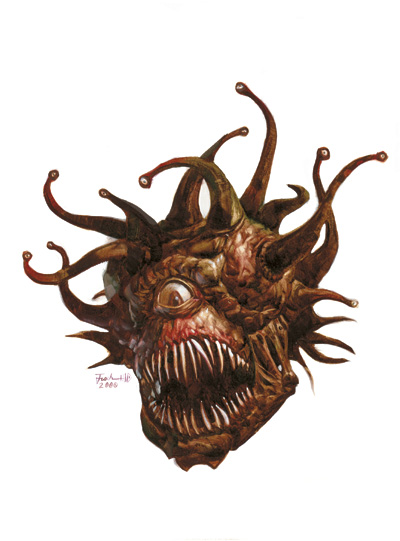 "border: 0px solid ; width: 73px; height: 75px;" /> Large Aberration
Hit Dice: 11d8+44 (93 hp)
Initiative: +6
Speed: 5 ft. (1 squares), fly 20 ft (good).
Armor Class: 26 (–1 size, +2 Dex, +15 natural), touch11, flat-footed 24
Base Attack/Grapple: +8/+12
Attack: Eye rays +9 ranged touch and bite +2 melee (2d4)
Full Attack: Eye rays +9 ranged touch and bite +2 melee (2d4)
Space/Reach: 10 ft./5 ft.
Special Attacks: Eye Rays
Special Qualities: All-around vision, antimagic cone, darkvision 60 ft., flight
Saves: Fort +9, Ref +5, Will +11
Abilities: Str 10, Dex 14, Con 18, Int 17, Wis 15, Cha 15
Skills: Hide +12, Knowledge (arcana) +17, Listen +18, Search +21, Spot +22, Survival +2 (+4 following tracks)
Feats: AlertnessB, Flyby Attack, Great Fortitude, Improved Initiative, Iron Will
Environment: Cold hills
Organization: Solitary, pair, or Cluster (3-6)
Challenge Rating: 13
Treasure: Double Standard
Alignment: Usually Lawful Evil
Advancement: 12–16 HD (Large); 17–33 HD (Huge)
Level Adjustment: —
"border: 0px solid ; width: 73px; height: 75px;" /> Large Aberration
Hit Dice: 11d8+44 (93 hp)
Initiative: +6
Speed: 5 ft. (1 squares), fly 20 ft (good).
Armor Class: 26 (–1 size, +2 Dex, +15 natural), touch11, flat-footed 24
Base Attack/Grapple: +8/+12
Attack: Eye rays +9 ranged touch and bite +2 melee (2d4)
Full Attack: Eye rays +9 ranged touch and bite +2 melee (2d4)
Space/Reach: 10 ft./5 ft.
Special Attacks: Eye Rays
Special Qualities: All-around vision, antimagic cone, darkvision 60 ft., flight
Saves: Fort +9, Ref +5, Will +11
Abilities: Str 10, Dex 14, Con 18, Int 17, Wis 15, Cha 15
Skills: Hide +12, Knowledge (arcana) +17, Listen +18, Search +21, Spot +22, Survival +2 (+4 following tracks)
Feats: AlertnessB, Flyby Attack, Great Fortitude, Improved Initiative, Iron Will
Environment: Cold hills
Organization: Solitary, pair, or Cluster (3-6)
Challenge Rating: 13
Treasure: Double Standard
Alignment: Usually Lawful Evil
Advancement: 12–16 HD (Large); 17–33 HD (Huge)
Level Adjustment: —
A beholder is an 8-foot-wide orb dominated by a central eye and a large, toothy maw. Ten smaller eyes on stalks sprout from the top of the orb.
COMBAT
Beholders often attack without provocation. Though not powerful physically, they often plow right into groups of opponents to use as many of their eyes as they can. When closing with an enemy, a beholder tries to cause as much disruption and confusion as possible.
Eye Rays (Su): Each of a beholder’s ten eye rays resembles a spell cast by a 13th- level caster. Each eye ray has a range of 150 feet and a save DC of 17. The save DCs are Charisma- based. The ten eye rays include:
Charm Monster: The target must succeed on a Will save or be affected as though by the spell. Beholders use this ray to confuse the opposition, usually employing it early in a fight. The beholder gen erally instructs a charmed target to either restrain a com rade or stand aside.
Charm Person: The target must succeed on a Will save or be affected as though by the spell. Beholders use this ray in the same manner as the charm monster ray.
Disintegrate: The target must succeed on a Fortitude save or be affected as though by the spell. The beholder likes to use this ray on any foe it considers a real threat.
Fear: This works like the spell, except that it targets one creature. The target must succeed on a Will save or be affected as though by the spell. Beholders like to use this ray against warriors and other powerful creatures early in a fight, to break up the opposition.
Finger of Death: The target must succeed on a Fortitude save or be slain as though by the spell. The target takes 3d6+13 points of dam age if its saving throw succeeds. Beholders use this ray to elimi nate dangerous foes quickly.
Flesh to Stone: The target must succeed on a Fortitude save or be affected as though by the spell. Beholders like to aim this ray at enemy spellcasters. They also use it on any creature whose appear ance they find interesting. (After the fight, the beholder takes the statue to its lair as a decoration.)
Inflict Moderate Wounds: This works like the spell, causing 2d8+10 points of damage (Will half ).
Sleep: This works like the spell, except that it affects one creature with any number of Hit Dice (Will negates). Beholders like to use this ray against warriors and other physically powerful creatures. They know their foes can quickly awaken the sleepers, but they also know that doing so takes time and can delay an effective counterattack.
Slow: This works like the spell, except that it affects one crea ture. The target can make a Will save to negate the effect. Behold ers often use this ray against the same creature targeted by their disintegrate, flesh to stone, or finger of death ray. If one of the former rays fails to eliminate the foe, this ray might at least hamper it.
Telekinesis: A beholder can move objects or creatures that weigh up to 325 pounds, as though with a telekinesis spell. Creatures can resist the effect with a successful Will save.
Antimagic Cone (Su): A beholder’s central eye continually produces a 150- foot cone of antimagic. This functions just like antimagic field (caster level 13th). All magical and supernatural powers and effects within the cone are suppressed—even the beholder’s own eye rays. Once each round, during its turn, the beholder decides whether the antimagic cone is active or not (the beholder deactivates the cone by shutting its central eye).
BEHOLDER SOCIETY
Beholders are hateful, aggressive, and avaricious, attacking or dominating others whenever they can get away with it. They exhibit a xenophobic intolerance, hating all creatures not like themselves. The basic body type comprises a great varietyof beholder subspecies. Some are covered with overlapping chitinous plates; some have smooth hides or snakelike eye tentacles; some have crustacean joints. But even a difference as small as hide color or size of the central eye can make two groups of beholders sworn enemies. Every beholder declares its own unique form to be the “true ideal of beholderhood,” the others being nothing but ugly replicas fit only to be eliminated.
Beholders usually carve out underground lairs for themselves using their disintegrate rays. Beholder architecture emphasizes the vertical, and a lair usually has a number of parallel tubes, with chambers stacked on top of each other. Beholders prefer inaccessible locations that earthbound foes can reach only with difficulty.
BELKER |
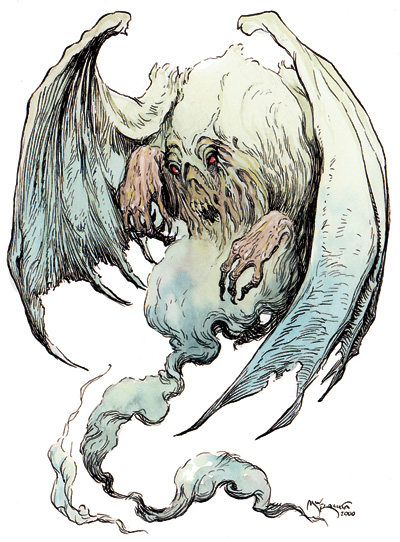 Large Elemental (Air, Extraplanar)
Hit Dice: 7d8+7 (38 hp)
Initiative: +5
Speed: 30 ft. (6 squares), fly 50 ft. (perfect)
Armor Class: 22 (–1 size, +5 Dex, +8 natural), touch 14, flat-footed 17
Base Attack/Grapple: +5/+11
Attack: Wing +9 melee (1d6+2)
Full Attack: 2 wings +9 melee (1d6+2) and bite +4 melee (1d4+1) and 2 claws +4 melee (1d3+1)
Space/Reach: 10 ft./10 ft.
Special Attacks: Smoke claws
Special Qualities: Darkvision 60 ft., elemental traits, smoke form
Saves: Fort +3, Ref +10, Will +2
Abilities: Str 14, Dex 21, Con 13, Int 6, Wis 11, Cha 11
Skills: Listen +7, Move Silently +9, Spot +7
Feats: Alertness, Multiattack, Weapon Finesse
Environment: Elemental Plane of Air
Organization: Solitary, pair, or clutch (3–4)
Challenge Rating: 6
Treasure: None
Alignment: Usually neutral evil
Advancement: 8–10 HD (Large); 11–21 HD (Huge)
Level Adjustment: —
Large Elemental (Air, Extraplanar)
Hit Dice: 7d8+7 (38 hp)
Initiative: +5
Speed: 30 ft. (6 squares), fly 50 ft. (perfect)
Armor Class: 22 (–1 size, +5 Dex, +8 natural), touch 14, flat-footed 17
Base Attack/Grapple: +5/+11
Attack: Wing +9 melee (1d6+2)
Full Attack: 2 wings +9 melee (1d6+2) and bite +4 melee (1d4+1) and 2 claws +4 melee (1d3+1)
Space/Reach: 10 ft./10 ft.
Special Attacks: Smoke claws
Special Qualities: Darkvision 60 ft., elemental traits, smoke form
Saves: Fort +3, Ref +10, Will +2
Abilities: Str 14, Dex 21, Con 13, Int 6, Wis 11, Cha 11
Skills: Listen +7, Move Silently +9, Spot +7
Feats: Alertness, Multiattack, Weapon Finesse
Environment: Elemental Plane of Air
Organization: Solitary, pair, or clutch (3–4)
Challenge Rating: 6
Treasure: None
Alignment: Usually neutral evil
Advancement: 8–10 HD (Large); 11–21 HD (Huge)
Level Adjustment: —
A mass of dark smoke moves against the breeze, shifting shape as it comes closer. Cloudlike, roiling, it suddenly explodes into a demonic creature of smoke and wind, with large bat wings, clawed tendrils, and a biting maw.
Belkers are creatures from the Plane of Air. They are composed primarily of smoke. Although undeniably evil, they are very reclusive and usually have no interest in the affairs of others. A belker’s winged shape makes it look distinctly demonic. It is about 7 feet long and weighs about 8 pounds.
A belker’s winged shape makes it look distinctly demonic. Because of its semigaseous nature, however, it shifts and changes shape with every puff of wind. It is about 7 feet long and weighs about 8 pounds
Belkers speak Auran.
COMBAT
In most cases, a belker fights with its nasty claws and painful bite.
Smoke Claws (Ex): A belker in smoke form (see below) can engulf opponents by moving on top of them. It fills the air around one Medium or smaller opponent without provoking an attack of opportunity. The target must succeed on a DC 14 Fortitude save or inhale part of the creature. The save DC is Constitution-based. Smoke inside the victim solidifies into a claw and begins to rip at the surrounding organs, dealing 3d4 points of damage per round. An affected creature can attempt another Fortitude save each subsequent round to cough out the semivaporous menace.
Smoke Form (Su): Most of the time a belker is more or less solid, but at will it can assume smoke form. It can switch forms once per round as a free action and can spend up to 20 rounds per day in smoke form. A belker in smoke form can fly at a speed of 50 feet (perfect). The ability is otherwise similar to a gaseous form spell (caster level 7th).
Skills: Belkers have a +4 racial bonus on Move Silently checks.
BLINK DOG |
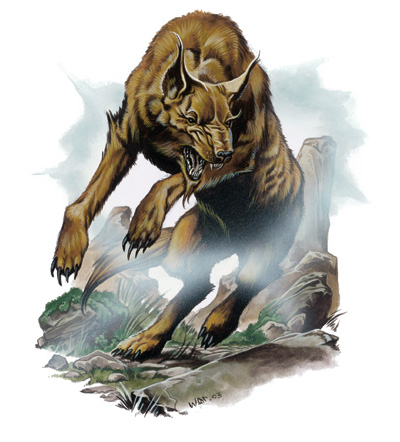 Medium Magical Beast
Hit Dice: 4d10 (22 hp)
Initiative: +3
Speed: 40 ft. (8 squares)
Armor Class: 16 (+3 Dex, +3 natural), touch 13, flat-footed 13
Base Attack/Grapple: +4/+4
Attack: Bite +4 melee (1d6)
Full Attack: Bite +4 melee (1d6)
Space/Reach: 5 ft./5 ft.
Special Attacks: —
Special Qualities: Blink, darkvision 60 ft.,
dimension door, low-light vision, scent
Saves: Fort +4, Ref +7, Will +4
Abilities: Str 10, Dex 17, Con 10, Int 10, Wis 13, Cha 11
Skills: Hide +3, Listen +5, Sense Motive +3, Spot +5,
Survival +4
Feats: Iron Will, Run, TrackB
Environment: Temperate plains
Organization: Solitary, pair, or pack (7–16)
Challenge Rating: 2
Treasure: None
Alignment: Usually lawful good
Advancement: 5–7 HD (Medium); 8–12 HD (Large)
Level Adjustment: +2 (cohort)
Medium Magical Beast
Hit Dice: 4d10 (22 hp)
Initiative: +3
Speed: 40 ft. (8 squares)
Armor Class: 16 (+3 Dex, +3 natural), touch 13, flat-footed 13
Base Attack/Grapple: +4/+4
Attack: Bite +4 melee (1d6)
Full Attack: Bite +4 melee (1d6)
Space/Reach: 5 ft./5 ft.
Special Attacks: —
Special Qualities: Blink, darkvision 60 ft.,
dimension door, low-light vision, scent
Saves: Fort +4, Ref +7, Will +4
Abilities: Str 10, Dex 17, Con 10, Int 10, Wis 13, Cha 11
Skills: Hide +3, Listen +5, Sense Motive +3, Spot +5,
Survival +4
Feats: Iron Will, Run, TrackB
Environment: Temperate plains
Organization: Solitary, pair, or pack (7–16)
Challenge Rating: 2
Treasure: None
Alignment: Usually lawful good
Advancement: 5–7 HD (Medium); 8–12 HD (Large)
Level Adjustment: +2 (cohort)
A big canine with yellow-brown fur and large ears appears completely ordinary. And then it disappears in the blink of an eye and instantly reappears in a different location.
The blink dog is an intelligent canine that has a limited teleportation ability.
Blink dogs are social animals, often traveling in packs. They eat equal amounts of meat and plant matter. They avoid human lands but drive off evil humanoids that enter their territory.
Blink dogs have their own language, a mixture of barks, yaps, whines, and growls that can transmit complex information. When not hunting, they are playful with each other but very protective of their pups, which outsiders sometimes steal to train as guard animals. Blink dogs and displacer beasts are natural enemies.
COMBAT
Blink dogs hunt in packs, teleporting in a seemingly random fashion until they surround their prey, allowing some of them to take advantage of flanking.
Blink (Su): A blink dog can use blink as the spell (caster level 8th), and can evoke or end the effect as a free action.
Dimension Door (Su): A blink dog can teleport, as dimension door (caster level 8th), once per round as a free action. The ability affects only the blink dog, which never appears within a solid object and can act immediately after teleporting.
BODAK |
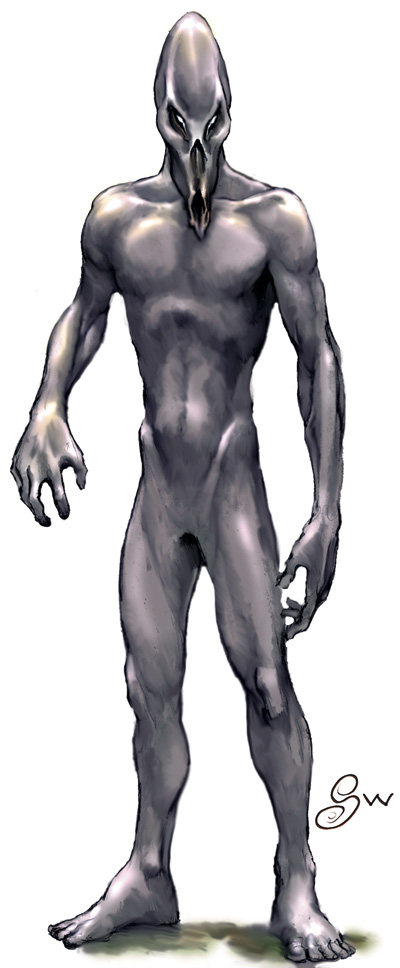 Medium Undead (Extraplanar)
Hit Dice: 9d12 (58 hp)
Initiative: +6
Speed: 20 ft. (4 squares)
Armor Class: 20 (+2 Dex, +8 natural), touch 12, flat-footed 18
Base Attack/Grapple: +4/+5
Attack: Slam +6 melee (1d8+1)
Full Attack: Slam +6 melee (1d8+1)
Space/Reach: 5 ft./5 ft.
Special Attacks: Death gaze
Special Qualities: Damage reduction
10/cold iron, darkvision 60 ft., immunity to electricity, resistance to acid 10 and fire 10, undead
traits, vulnerability to sunlight
Saves: Fort +3, Ref +5, Will +7
Abilities: Str 13, Dex 15, Con —, Int 6, Wis 12, Cha 12
Skills: Listen +11, Move Silently +10, Spot +11
Feats: Alertness, Dodge, Improved Initiative, Weapon
Focus (slam)
Environment: Infinite Layers of the Abyss
Organization: Solitary or gang (2–4)
Challenge Rating: 8
Treasure: None
Alignment: Always chaotic evil
Advancement: 10–13 HD (Medium); 14–27 HD (Large)
Level Adjustment: —
Medium Undead (Extraplanar)
Hit Dice: 9d12 (58 hp)
Initiative: +6
Speed: 20 ft. (4 squares)
Armor Class: 20 (+2 Dex, +8 natural), touch 12, flat-footed 18
Base Attack/Grapple: +4/+5
Attack: Slam +6 melee (1d8+1)
Full Attack: Slam +6 melee (1d8+1)
Space/Reach: 5 ft./5 ft.
Special Attacks: Death gaze
Special Qualities: Damage reduction
10/cold iron, darkvision 60 ft., immunity to electricity, resistance to acid 10 and fire 10, undead
traits, vulnerability to sunlight
Saves: Fort +3, Ref +5, Will +7
Abilities: Str 13, Dex 15, Con —, Int 6, Wis 12, Cha 12
Skills: Listen +11, Move Silently +10, Spot +11
Feats: Alertness, Dodge, Improved Initiative, Weapon
Focus (slam)
Environment: Infinite Layers of the Abyss
Organization: Solitary or gang (2–4)
Challenge Rating: 8
Treasure: None
Alignment: Always chaotic evil
Advancement: 10–13 HD (Medium); 14–27 HD (Large)
Level Adjustment: —
This creature is a gray-fleshed, hairless humanoid with an elongated skull-like head, noseless face, and white, empty eyes.
Bodaks are the undead remnants of humanoids who have been destroyed by the touch of absolute evil.
A bodak retains fleeting memories of its past life and can speak Common (or some other humanoid language)
COMBAT
Death Gaze (Su): Death, range 30 feet, Fortitude DC 15 negates. Humanoids who die from this attack are transformed into bodaks 24 hours later. The save DC is Charisma-based.
Vulnerability to Sunlight (Ex): Bodaks loathe sunlight, for its merest touch burns their impure flesh. Each round of exposure to the direct rays of the sun deals 1 point of damage to the creature.
BUGBEAR |
 Medium Humanoid (Goblinoid)
Hit Dice: 3d8+3 (16 hp)
Initiative: +1
Speed: 30 ft. (6 squares)
Armor Class: 17 (+1 Dex, +3 natural, +2 leather armor, +1 light wooden shield), touch 11, flat-footed 16
Base Attack/Grapple: +2/+4
Attack: Morningstar +5 melee (1d8+2) or javelin +3 ranged (1d6+2)
Full Attack: Morningstar +5 melee (1d8+2) or javelin +3 ranged (1d6+2)
Space/Reach: 5 ft./5 ft.
Special Attacks: —
Special Qualities: Darkvision 60 ft., scent
Saves: Fort +2, Ref +4, Will +1
Abilities: Str 15, Dex 12, Con 13, Int 10, Wis 10, Cha 9
Skills: Climb +3, Hide +4, Listen +4, Move Silently
+6, Spot +4
Feats: Alertness, Weapon Focus (morningstar)
Environment: Temperate mountains
Organization: Solitary, gang (2–4), or band (11–20 plus 150% noncombatants plus 2 2nd-level sergeants
and 1 leader of 2nd–5th level)
Challenge Rating: 2
Treasure: Standard
Alignment: Usually chaotic evil
Advancement: By character class
Level Adjustment: +1
Medium Humanoid (Goblinoid)
Hit Dice: 3d8+3 (16 hp)
Initiative: +1
Speed: 30 ft. (6 squares)
Armor Class: 17 (+1 Dex, +3 natural, +2 leather armor, +1 light wooden shield), touch 11, flat-footed 16
Base Attack/Grapple: +2/+4
Attack: Morningstar +5 melee (1d8+2) or javelin +3 ranged (1d6+2)
Full Attack: Morningstar +5 melee (1d8+2) or javelin +3 ranged (1d6+2)
Space/Reach: 5 ft./5 ft.
Special Attacks: —
Special Qualities: Darkvision 60 ft., scent
Saves: Fort +2, Ref +4, Will +1
Abilities: Str 15, Dex 12, Con 13, Int 10, Wis 10, Cha 9
Skills: Climb +3, Hide +4, Listen +4, Move Silently
+6, Spot +4
Feats: Alertness, Weapon Focus (morningstar)
Environment: Temperate mountains
Organization: Solitary, gang (2–4), or band (11–20 plus 150% noncombatants plus 2 2nd-level sergeants
and 1 leader of 2nd–5th level)
Challenge Rating: 2
Treasure: Standard
Alignment: Usually chaotic evil
Advancement: By character class
Level Adjustment: +1
This muscular, savage humanoid stands 7 feet tall. Coarse hair covers most of its body. Its mouth is full of long, sharp fangs, and its nose is much like that of a bear.
The biggest and strongest of the goblinoids, bugbears are more aggressive than their smaller relatives. They live by hunting any creature weaker than themselves.
The bugbear’s nose is the cause of its name, though the creature is not related to bears. Its hide and sharp claws also resemble those of bears. A bugbear’s hands are far more dexterous than a bear’s paws, however, and its claws are too small to make effective weapons.
Bugbears speak Goblin and Common.
COMBAT
Bugbears prefer to ambush opponents whenever possible. When hunting, they normally send scouts ahead of the main group that, if they spy prey, return to report and bring up reinforcements. Bugbear attacks are coordinated, and their tactics are sound if not brilliant.
Skills: Bugbears have a +4 racial bonus on Move Silently checks.
BUGBEAR SOCIETY
Bugbears prefer to dwell in temperate, mountainous regions with many caves, living in small tribal units. A single bugbear, usually the biggest and meanest, leads each tribe. A tribe has as many young as it has adults. Children do not join the adults in the hunt, but they will fight to protect themselves or their lairs.
Bugbears have only two genuine goals in life: food and treasure. Prey and intruders are considered a valuable source of both. These extremely greedy creatures prize anything shiny, including arms and armor. They never miss an opportunity to increase their hoards through theft, plunder, and ambush. On rare occasions they parley with other beings if they believe something can be gained, but they are not skilled negotiators, losing their patience quickly if such encounters run overlong. They are sometimes found commanding goblins and hobgoblins, whom they bully mercilessly.
Bugbears survive primarily by hunting, and they eat whatever they can bring down. Any creature is a legitimate source of food, including monsters and even their own smaller kin. When game is scarce, bugbears turn to raiding and ambush to fill their stewpots.
Most bugbears revere a deity named Hruggek, who delights in ambushes followed by furious combat.
BUGBEARS AS CHARACTERS
Bugbear characters possess the following racial traits.
-
+4 Strength, +2 Dexterity, +2 Constitution, –2 Charisma.
-
Medium size.
-
A bugbear’s base land speed is 30 feet.
-
Darkvision out to 60 feet.
-
Racial Hit Dice: A bugbear begins with three levels of humanoid, which provide 3d8 Hit Dice, a base attack bonus of +2, and base saving throw bonuses of Fort +1, Ref +3, and Will +1.
-
Racial Skills: A bugbear’s humanoid levels give it skill points equal to 6 x (2 + Int modifier). Its class skills are Climb, Hide, Listen, Move Silently, Search, and Spot.
-
Racial Feats: A bugbear’s humanoid levels give it two feats.
-
+3 natural armor bonus.
-
+4 racial bonus on Move Silently checks.
-
Automatic Languages: Common, Goblin. Bonus Languages: Draconic, Elven, Giant, Gnoll, Orc.
-
Favored Class: Rogue.
-
Level adjustment +1.
BULETTE |
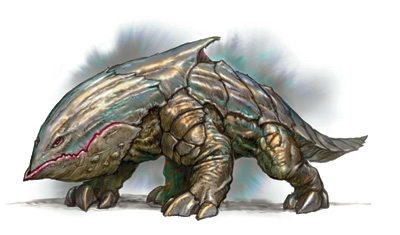 Huge Magical Beast
Hit Dice: 9d10+45 (94 hp)
Initiative: +2
Speed: 40 ft. (8 squares), burrow 10 ft.
Armor Class: 22 (–2 size, +2 Dex, +12 natural), touch 10, flat-footed 20
Base Attack/Grapple: +9/+25
Attack: Bite +16 melee (2d8+8)
Full Attack: Bite +16 melee (2d8+8) and 2 claws +10 melee (2d6+4)
Space/Reach: 15 ft./10 ft.
Special Attacks: Leap
Special Qualities: Darkvision 60 ft., low-light vision, scent, tremorsense 60 ft.
Saves: Fort +11, Ref +8, Will +6
Abilities: Str 27, Dex 15, Con 20, Int 2, Wis 13, Cha 6
Skills: Jump +18, Listen +9, Spot +3
Feats: Alertness, Iron Will, Track, Weapon Focus
(bite)
Environment: Temperate hills
Organization: Solitary or pair
Challenge Rating: 7
Treasure: None
Alignment: Always neutral
Advancement: 10–16 HD (Huge); 17–27 HD (Gargantuan)
Level Adjustment: —
Huge Magical Beast
Hit Dice: 9d10+45 (94 hp)
Initiative: +2
Speed: 40 ft. (8 squares), burrow 10 ft.
Armor Class: 22 (–2 size, +2 Dex, +12 natural), touch 10, flat-footed 20
Base Attack/Grapple: +9/+25
Attack: Bite +16 melee (2d8+8)
Full Attack: Bite +16 melee (2d8+8) and 2 claws +10 melee (2d6+4)
Space/Reach: 15 ft./10 ft.
Special Attacks: Leap
Special Qualities: Darkvision 60 ft., low-light vision, scent, tremorsense 60 ft.
Saves: Fort +11, Ref +8, Will +6
Abilities: Str 27, Dex 15, Con 20, Int 2, Wis 13, Cha 6
Skills: Jump +18, Listen +9, Spot +3
Feats: Alertness, Iron Will, Track, Weapon Focus
(bite)
Environment: Temperate hills
Organization: Solitary or pair
Challenge Rating: 7
Treasure: None
Alignment: Always neutral
Advancement: 10–16 HD (Huge); 17–27 HD (Gargantuan)
Level Adjustment: —
The ground shakes and rolls and then bursts open to reveal a terrible, armor-plated, bullet-shaped creature with a huge snapping maw and short, powerful legs.
Also known as the landshark, the bulette is a terrifying predator that lives only to eat. It is universally shunned, even by other monsters. Fortunately for the rest of the world, the bulette is a solitary animal, although mated pairs (very rare) might share the same territory. Since its appetite is so voracious, each bulette has a large territory that can range up to 30 square miles. Other predators rarely share territory with one, for fear of being eaten. A bulette has no lair, preferring to wander above and below ground; it burrows beneath the soil to rest.
A bulette totally consumes its victims—clothing, weapons, and all. Its powerful stomach acid quickly destroys armor, weapons, and even magic items. It is not above nibbling on chests or sacks of coins either. When it has eaten everything in its territory, a bulette moves on. The sole criterion for a suitable territory is availability of food, so bulettes occasionally locate themselves near human settlements and terrorize the residents.
COMBAT
A bulette attacks anything it regards as edible, choosing the easiest or closest prey first. The only creatures it refuses to eat are elves (and it dislikes the taste of dwarves). When burrowing underground, a landshark relies on its tremorsense ability to detect prey. When it senses something edible (that is, senses movement), it breaks to the surface, crest first, and begins its attack.
The bulette has a foul temperament—stupid, mean, and fearless. The size, strength, and number of its opponents mean nothing.
Leap (Ex): A bulette can jump into the air during combat. This allows it to make four claw attacks instead of two, each with a +15 attack bonus, but it cannot bite.
CARRION CRAWLER |
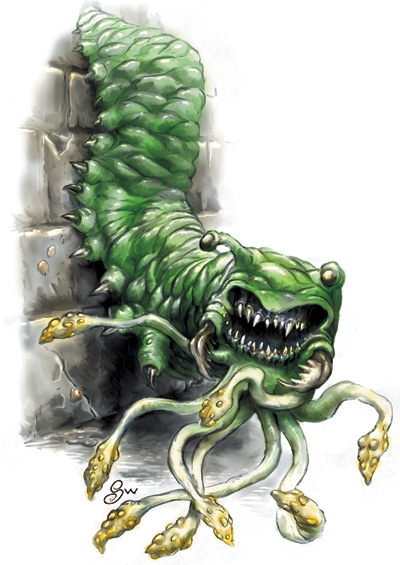 Large Aberration
Hit Dice: 3d8+6 (19 hp)
Initiative: +2
Speed: 30 ft. (6 squares), climb 15 ft.
Armor Class: 17 (–1 size, +2 Dex, +6 natural), touch 11, flat-footed 15
Base Attack/Grapple: +2/+8
Attack:
3 melee (paralysis) Full Attack: 8 tentacles +3 melee (paralysis) and bite –2 melee (1d4+1)
Space/Reach: 10 ft./5 ft.
Special Attacks: Paralysis
Special Qualities: Darkvision 60 ft., scent
Saves: Fort +3, Ref +3, Will +5
Abilities: Str 14, Dex 15, Con 14, Int 1, Wis 15, Cha 6
Skills: Climb +12, Listen +6, Spot +6
Feats: AlertnessB, Combat Reflexes, Track
Environment: Underground
Organization: Solitary, pair, or cluster (3–5)
Challenge Rating: 4
Treasure: None
Alignment: Always neutral
Advancement: 4–6 HD (Large); 7–9 HD (Huge)
Level Adjustment: —
Large Aberration
Hit Dice: 3d8+6 (19 hp)
Initiative: +2
Speed: 30 ft. (6 squares), climb 15 ft.
Armor Class: 17 (–1 size, +2 Dex, +6 natural), touch 11, flat-footed 15
Base Attack/Grapple: +2/+8
Attack:
3 melee (paralysis) Full Attack: 8 tentacles +3 melee (paralysis) and bite –2 melee (1d4+1)
Space/Reach: 10 ft./5 ft.
Special Attacks: Paralysis
Special Qualities: Darkvision 60 ft., scent
Saves: Fort +3, Ref +3, Will +5
Abilities: Str 14, Dex 15, Con 14, Int 1, Wis 15, Cha 6
Skills: Climb +12, Listen +6, Spot +6
Feats: AlertnessB, Combat Reflexes, Track
Environment: Underground
Organization: Solitary, pair, or cluster (3–5)
Challenge Rating: 4
Treasure: None
Alignment: Always neutral
Advancement: 4–6 HD (Large); 7–9 HD (Huge)
Level Adjustment: —
The stink of rotten meat surrounds this multilegged creature with a segmented, 10-foot-long body. Eight writhing tentacles protrude from its head, growing directly from below its clacking mandibles and toothfilled maw.
Carrion crawlers are aggressive subterranean scavengers, greatly feared for their paralyzing attacks. They scour their underground territory for dead and decaying flesh but won’t hesitate to attack and kill living creatures.
Each of a carrion crawler’s tentacles is about 2 feet long and secretes a sticky, paralyzing substance. Like so many hybrid monsters, the carrion crawler may well be the result of arcane experimentation. A carrion crawler weighs about 500 pounds.
COMBAT
Carrion crawlers use their senses of sight and smell to detect carcasses and potential prey. When attacking, a crawler lashes out with its tentacles and tries to paralyze its victim. The tentacles deal no other damage. The creature then kills the paralyzed victim with its bite and devours the flesh. Multiple crawlers do not fight in concert, but each paralyzes as many opponents as possible. The unintelligent creature continues to attack as long as it faces any moving opponents.
Paralysis (Ex): Those hit by a carrion crawler’s tentacle attack must succeed on a DC 13 Fortitude save or be paralyzed for 2d4 rounds. The save DC is Constitu- tion-based.
Skills: Carrion crawlers have a +8 racial bonus on Climb checks and can always choose to take 10 on Climb checks, even if rushed or threatened
CELESTIAL CREATURE |
Celestial creatures dwell on the upper planes, the realms of good, although they resemble beings found on the Material Plane. They are more regal and more beautiful than their earthly counterparts.
Celestial creatures often come in metallic colors (usually silver, gold, or platinum). They can be mistaken for half-celestials, more powerful creatures that are created when a celestial mates with a noncelestial creature.
CREATING A CELESTIAL CREATURE
“Celestial” is an inherited template that can be added to any corporeal animal, aberration, animal, dragon, fey, giant, humanoid, magical beast, monstrous humanoid, plant, or vermin of good or neutral alignment (referred to hereafter as the base creature).
A celestial creature uses all the base creature’s statistics and abilities except as noted here. Do not recalculate the creature’s Hit Dice, base attack bonus, saves, or skill points if its type changes.
Size and Type: Animals or vermin with this template become magical beasts, but otherwise the creature type is unchanged. Size is unchanged. Celestial creatures encountered on the Material Plane have the extraplanar subtype.
Special Attacks: A celestial creature retains all the special attacks of the base creature and also gains the following attack.
Smite Evil (Su): Once per day a celestial creature can make a normal melee attack to deal extra damage equal to its HD (maximum of +20) against an evil foe.
Special Qualities: A celestial creature retains all the special qualities of the base creature and also gains the following qualities.
-
Darkvision out to 60 feet.
-
Damage reduction (see the table below).
-
Resistance to acid, cold, and electricity (see the table below).
-
Spell resistance equal to HD + 5 (maximum 25).
| Hit Dice | Resistance to Acid, Cold, Electricity |
Damage Reduction |
|---|---|---|
| 1–3 | 5 | — |
| 4–7 | 5 | 5/magic |
| 8–11 | 10 | 5/magic |
| 12 or more | 10 | 10/magic |
If the base creature already has one or more of these special qualities, use the better value.
If a celestial creature gains damage reduction, its natural weapons are treated as magic weapons for the purpose of overcoming damage reduction.
Abilities: Same as the base creature, but Intelligence is at least 3.
Environment: Any good-aligned plane.
Challenge Rating: HD 3 or less, as base creature; HD 4 to 7, as base creature +1; HD 8 or more, as base creature +2.
Alignment: Always good (any).
Level Adjustment: Same as the base creature +2.
CENTAUR |
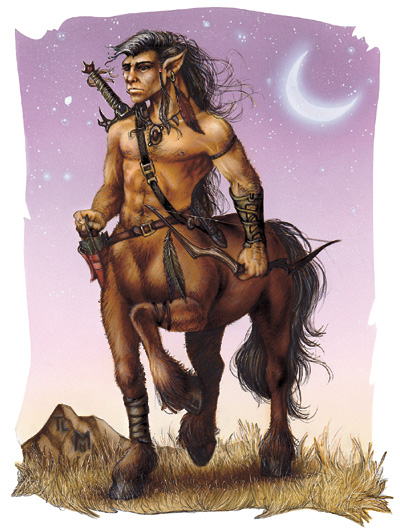 Large Monstrous Humanoid
Hit Dice: 4d8+8 (26 hp)
Initiative: +2
Speed: 50 ft. (10 squares)
Armor Class: 14 (–1 size, +2 Dex, +3 natural), touch 11, flat-footed 12
Base Attack/Grapple: +4/+12
Attack: Longsword +7 melee (2d6+6/19–20) or composite longbow (+4 Str bonus) +5 ranged (2d6+4/x3)
Full Attack: Longsword +7 melee (2d6+6/19–20) and 2 hooves +3 melee (1d6+2); or composite longbow (+4 Str
bonus) +5 ranged (2d6+4/x3)
Space/Reach: 10 ft./5 ft.
Special Attacks: —
Special Qualities: Darkvision 60 ft.
Saves: Fort +3, Ref +6, Will +5
Abilities: Str 18, Dex 14, Con 15, Int 8, Wis 13, Cha 11
Skills: Listen +3, Move Silently +4, Spot +3, Survival
+2
Feats: Dodge, Weapon Focus (hoof )
Environment: Temperate forests
Organization: Solitary, company (5–8), troop (8–18 plus 1 leader of 2nd–5th level), or tribe
(20–150 plus 30% noncombatants plus 10 3rd-level sergeants, 5 5th-level lieutenants, and 1 leader of 5th–9th level)
Challenge Rating: 3
Treasure: Standard
Alignment: Usually neutral good
Advancement: By character class
Level Adjustment: +2
Large Monstrous Humanoid
Hit Dice: 4d8+8 (26 hp)
Initiative: +2
Speed: 50 ft. (10 squares)
Armor Class: 14 (–1 size, +2 Dex, +3 natural), touch 11, flat-footed 12
Base Attack/Grapple: +4/+12
Attack: Longsword +7 melee (2d6+6/19–20) or composite longbow (+4 Str bonus) +5 ranged (2d6+4/x3)
Full Attack: Longsword +7 melee (2d6+6/19–20) and 2 hooves +3 melee (1d6+2); or composite longbow (+4 Str
bonus) +5 ranged (2d6+4/x3)
Space/Reach: 10 ft./5 ft.
Special Attacks: —
Special Qualities: Darkvision 60 ft.
Saves: Fort +3, Ref +6, Will +5
Abilities: Str 18, Dex 14, Con 15, Int 8, Wis 13, Cha 11
Skills: Listen +3, Move Silently +4, Spot +3, Survival
+2
Feats: Dodge, Weapon Focus (hoof )
Environment: Temperate forests
Organization: Solitary, company (5–8), troop (8–18 plus 1 leader of 2nd–5th level), or tribe
(20–150 plus 30% noncombatants plus 10 3rd-level sergeants, 5 5th-level lieutenants, and 1 leader of 5th–9th level)
Challenge Rating: 3
Treasure: Standard
Alignment: Usually neutral good
Advancement: By character class
Level Adjustment: +2
The creature gallops out of the trees, its thundering hooves echoing throughout the forest. It has the upper torso, arms, and head of a humanoid, and the lower body of a large horse. It carries a longbow, drawn and nocked, ready to loose an arrow at the first hint of danger.
Centaurs are woodland beings who shun the company of strangers. They are deadly archers and even more fearsome in melee.
A centaur is as big as a heavy horse, but much taller and slightly heavier. A centaur is about 7 feet tall and weighs about 2,100 pounds.
Centaurs speak Sylvan and Elven.
COMBAT
Although generally mild-tempered, centaurs are always armed. Their favorite melee weapon is the longsword. When scouting or hunting, they carry composite longbows. A centaur employing a lance deals double damage when it charges, just as a rider on a mount does.
Centaurs usually don’t provoke a fight. Their normal response to aggression is swift retreat, perhaps after launching a few arrows to discourage pursuit. Against creatures powerful enough to pose danger to the tribe, they appear to use this same tactic, except that about half of the “retreating” centaurs will circle around to lie in ambush or attack the foe from the rear.
CENTAUR SOCIETY
Among their own kind, centaurs are sociable creatures, but they have been known to become rowdy, boorish, and aggressive when under the influence of alcohol.
Solitary centaurs are usually out hunting or scouting. Companies and troops are usually hunting or scouting in force. Most of the members of a centaur tribe remain near their lair. Most of the centaurs in the tribal lair are female; while the males are out hunting and scouting, the females lead and administer the tribe. A third of a tribe’s population is young.
The typical centaur lair is located deep within a forest. It consists of a large hidden glade and pastures, with a good supply of running water. Depending on the climate, the lair may contain huts or lean-tos to shelter individual families. Hearths for cooking and warmth are in an open area, away from the trees.
Centaurs are skilled in horticulture and may cultivate useful plants near their lair. In dangerous, monster-infested areas they plant thick barriers of thorn bushes around their lair, dig pits, and set snares.
Centaurs survive through a mixture of hunting, foraging, fishing, agriculture, and trade. Though they shun dealings with humans, centaurs do trade with elves, especially for food and wine. The elves are paid from the tribe’s treasury, which consists of the booty of slain monsters.
The size of a centaur tribe’s territory varies with its population and the nature of the area it inhabits. Centaurs do not object to sharing territory with elves. The attitude of a centaur toward a stranger in its territory depends on the visitor. Humans and dwarves are politely asked to leave, halflings or gnomes are tolerated, and elves are welcomed.
Centaurs deal with monsters according to how much of a threat they are to the welfare and survival of the tribe: If a giant or dragon were to enter a tribe’s territory, the centaurs would relocate, but they would attempt to kill trolls, orcs, and the like.
Most centaurs revere a deity named Skerrit, who is a god of nature and community
CENTAURS AS CHARACTERS
A centaur druid is usually a tribe’s designated leader and speaker. Centaur characters possess the following racial traits.
-
+8 Strength, +4 Dexterity, +4 Constitution, –2 Intelligence, +2 Wisdom.
-
Large size. –1 penalty to Armor Class, –1 penalty on attack rolls, –4 penalty on Hide checks, +4 bonus on grapple checks, lifting and carrying limits double those of Medium characters.
-
Space/Reach: 10 feet/5 feet.
-
A centaur’s base land speed is 50 feet.
-
Darkvision out to 60 feet.
-
Racial Hit Dice: A centaur begins with four levels of monstrous humanoid, which provide 4d8 Hit Dice, a base attack bonus of +4, and base saving throw bonuses of Fort +1, Ref +4, and Will +4.
-
Racial Skills: A centaur’s monstrous humanoid levels give it skill points equal to 7 x (2 + Int modifier). Its class skills are Listen, Move Silently, Spot, and Survival.
-
Racial Feats: A centaur’s monstrous humanoid levels give it two feats.
-
+3 natural armor bonus.
-
Automatic Languages: Sylvan, Elven. Bonus Languages: Common, Gnome, Halfling.
-
Favored Class: Ranger.
-
Level adjustment +2.
CHAOS BEAST |
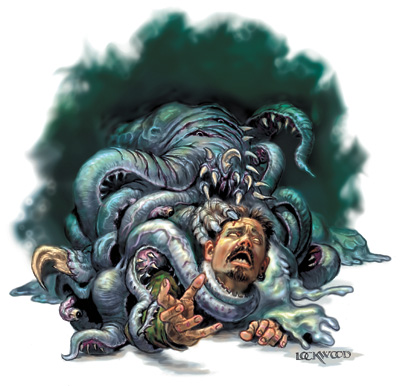 Medium Outsider (Chaotic, Extraplanar)
Hit Dice: 8d8+8 (44 hp)
Initiative: +5
Speed: 20 ft. (4 squares)
Armor Class: 16 (+1 Dex, +5 natural), touch 11, flat-footed 15
Base Attack/Grapple: +8/+10
Attack: Claw +10 melee (1d3+2 plus corporeal instability)
Full Attack: 2 claws +10 melee (1d3+2 plus corporeal instability)
Space/Reach: 5 ft./5 ft.
Special Attacks: Corporeal instability
Special Qualities: Darkvision 60 ft., immunity to critical hits and transformation, spell resistance 15
Saves: Fort +7, Ref +7, Will +6
Abilities: Str 14, Dex 13, Con 13, Int 10, Wis 10, Cha 10
Skills: Climb +13, Escape Artist +12, Hide +12, Jump +9, Listen +11, Search +11, Spot +11, Survival +0 (+2 following tracks), Tumble +14, Use Rope +1 (+3 with bindings)
Feats: Dodge, Improved Initiative, Mobility
Environment: Ever-Changing Chaos of Limbo
Organization: Solitary
Challenge Rating: 7
Treasure: None
Alignment: Always chaotic neutral
Advancement: 9–12 HD (Medium); 13–24 HD (Large)
Level Adjustment: —
Medium Outsider (Chaotic, Extraplanar)
Hit Dice: 8d8+8 (44 hp)
Initiative: +5
Speed: 20 ft. (4 squares)
Armor Class: 16 (+1 Dex, +5 natural), touch 11, flat-footed 15
Base Attack/Grapple: +8/+10
Attack: Claw +10 melee (1d3+2 plus corporeal instability)
Full Attack: 2 claws +10 melee (1d3+2 plus corporeal instability)
Space/Reach: 5 ft./5 ft.
Special Attacks: Corporeal instability
Special Qualities: Darkvision 60 ft., immunity to critical hits and transformation, spell resistance 15
Saves: Fort +7, Ref +7, Will +6
Abilities: Str 14, Dex 13, Con 13, Int 10, Wis 10, Cha 10
Skills: Climb +13, Escape Artist +12, Hide +12, Jump +9, Listen +11, Search +11, Spot +11, Survival +0 (+2 following tracks), Tumble +14, Use Rope +1 (+3 with bindings)
Feats: Dodge, Improved Initiative, Mobility
Environment: Ever-Changing Chaos of Limbo
Organization: Solitary
Challenge Rating: 7
Treasure: None
Alignment: Always chaotic neutral
Advancement: 9–12 HD (Medium); 13–24 HD (Large)
Level Adjustment: —
Foul and terrible, the creature before you has no set form. It constantly melts and reforms, apparently drawing each shape from every nightmare that has ever plagued humankind. It chaotically shifts through a dozen monstrous forms before shaping itself into a bulbous thing with ten eyes swimming in a viscous sac at the top of a body that’s surrounded by a ring of smacking mouths.
The horrific creatures known as chaos beasts have mutable, ever-changing forms. Their deadly touch can make opponents melt into formless goo.
There’s no telling what a chaos beast will look like. One moment it might be a towering horror of hooks and fangs, all pulpy flesh and exposed veins, and the next a slithering mass of ropy, vermilion-tipped tentacles. Then it become a mighty creature, all muscle and fury A chaos beast’s dimensions vary, but it always weighs about 200 pounds.
Chaos beasts do not speak.
COMBAT
For all its fearsome appearances, whether it has claws, fangs, pincers, tentacles, or spines, a chaos beast does little physical harm. Regardless of form, the creature seems unable to manage more than two attacks per round. Its continual transmutations prevent the coordination needed to do more.
A chaos beast’s claw attacks, as well as any weapons it wields, are treated as chaotic-aligned for the purpose of overcoming damage reduction.
Corporeal Instability (Su): A blow from a chaos beast against a living creature can cause a terrible transformation. The creature must succeed on a DC 15 Fortitude save or become a spongy, amorphous mass. Unless the victim manages to control the effect (see below), its shape melts, flows, writhes, and boils. The save DC is Constitution-based.
An affected creature is unable to hold or use any item. Clothing, armor, rings, and helmets become useless. Large items worn or carried - armor, backpacks, even shirts - hamper more than help, reducing the victim’s Dexterity score by 4. Soft or misshapen feet and legs reduce speed to 10 feet or one-quarter normal, whichever is less. Searing pain courses along the nerves, so strong that the victim cannot act coherently. The victim cannot cast spells or use magic items, and it attacks blindly, unable to distinguish friend from foe (–4 penalty on attack rolls and a 50% miss chance, regardless of the attack roll).
Each round the victim spends in an amorphous state causes 1 point of Wisdom drain from mental shock. If the victim’s Wisdom score falls to 0, it becomes a chaos beast.
A victim can regain its own shape by taking a standard action to attempt a DC 15 Charisma check (this check DC does not vary for a chaos beast with different Hit Dice or ability scores). A success reestablishes the creature’s normal form for 1 minute. On a failure, the victim can still repeat this check each round until successful.
Corporeal instability is not a disease or a curse and so is hard to remove. A shapechange or stoneskin spell does not cure an afflicted creature but fixes its form for the duration of the spell. A restoration, heal, or greater restoration spell removes the affliction (a separate restoration is necessary to restore any drained points of Wisdom).
Immunity to Transformation (Ex): No mortal magic can permanently affect or fix a chaos beast’s form. Effects such as polymorphing or petrification force the creature into a new shape, but at the start of its next turn it immediately returns to its mutable form as a free action.
CHIMERA |
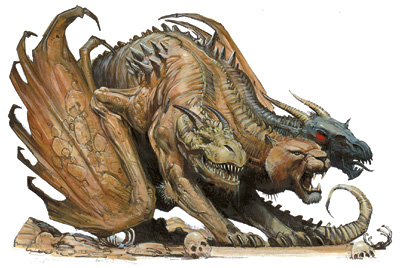 Large Magical Beast
Hit Dice: 9d10+27 (76 hp)
Initiative: +1
Speed: 30 ft. (6 squares), fly 50 ft. (poor)
Armor Class: 19 (–1 size, +1 Dex, +9 natural), touch 10, flat-footed 18
Base Attack/Grapple: +9/+17
Attack: Bite +12 melee (2d6+4)
Full Attack: Bite +12 melee (2d6+4) and bite +12 melee (1d8+4) and gore +12 melee (1d8+4) and 2 claws +10 melee
(1d6+2)
Space/Reach: 10 ft./5 ft.
Special Attacks: Breath
weapon
Special Qualities: Darkvision 60 ft., low-light vision, scent
Saves: Fort +9, Ref +7, Will +6
Abilities: Str 19, Dex 13, Con 17, Int 4, Wis 13, Cha 10
Skills: Hide +1*, Listen +9, Spot +9
Feats: Alertness, Hover, Iron Will, Multiattack
Environment: Temperate hills
Organization: Solitary, pride (3–5), or flight (6–13)
Challenge Rating: 7
Treasure: Standard
Alignment: Usually chaotic evil
Advancement: 10–13 HD (Large); 14–27 HD (Huge)
Level Adjustment: +2 (cohort)
Large Magical Beast
Hit Dice: 9d10+27 (76 hp)
Initiative: +1
Speed: 30 ft. (6 squares), fly 50 ft. (poor)
Armor Class: 19 (–1 size, +1 Dex, +9 natural), touch 10, flat-footed 18
Base Attack/Grapple: +9/+17
Attack: Bite +12 melee (2d6+4)
Full Attack: Bite +12 melee (2d6+4) and bite +12 melee (1d8+4) and gore +12 melee (1d8+4) and 2 claws +10 melee
(1d6+2)
Space/Reach: 10 ft./5 ft.
Special Attacks: Breath
weapon
Special Qualities: Darkvision 60 ft., low-light vision, scent
Saves: Fort +9, Ref +7, Will +6
Abilities: Str 19, Dex 13, Con 17, Int 4, Wis 13, Cha 10
Skills: Hide +1*, Listen +9, Spot +9
Feats: Alertness, Hover, Iron Will, Multiattack
Environment: Temperate hills
Organization: Solitary, pride (3–5), or flight (6–13)
Challenge Rating: 7
Treasure: Standard
Alignment: Usually chaotic evil
Advancement: 10–13 HD (Large); 14–27 HD (Huge)
Level Adjustment: +2 (cohort)
This creature has the hindquarters of a big goat and the forequarters of a great lion. It has dragon wings and three heads: a horned goat, a maneless lion, and a fierce dragon.
The chimera is a bizarre predator that hunts on the ground and on the wing. It can defeat even the hardiest opponent with a flurry of claws and fangs.
A chimera is about 5 feet tall at the shoulder, nearly 10 feet long, and weighs about 4,000 pounds. A chimera’s dragon head might be black, blue, green, red, or white.
Chimeras can speak Draconic but seldom bother to do so, except when toadying to more powerful creatures.
COMBAT
The chimera prefers to surprise prey. It often swoops down from the sky or lies concealed until it charges. The dragon head can loose a breath weapon instead of biting. Several chimeras attack in concert.
Breath Weapon (Su): A chimera’s breath weapon depends on the color of its dragon head, as summarized on the table below. Regardless of its type, a chimera’s breath weapon is usable once every 1d4 rounds, deals 3d8 points of damage, and allows a DC 17 Reflex save for half damage. The save DC is Constitution-based.
To determine a chimera’s head color and breath weapon randomly, roll 1d10 and consult the table below.
| 1d10 | Head Color | Breath Weapon |
|---|---|---|
| 1–2 | Black | 40-foot line of acid |
| 3–4 | Blue | 40-foot line of lightning |
| 5–6 | Green | 20-foot cone of gas (acid) |
| 7–8 | Red | 20-foot cone of fire |
| 9–10 | White | 20-foot cone of cold |
Skills: A chimera’s three heads give it a +2 racial bonus on Spot and Listen checks.
*In areas of scrubland or brush, a chimera gains a +4 racial bonus on Hide checks.
Carrying Capacity: A light load for a chimera is up to 348 pounds; a medium load, 349–699 pounds, and a heavy load, 700–1,050 pounds.
CHOKER |
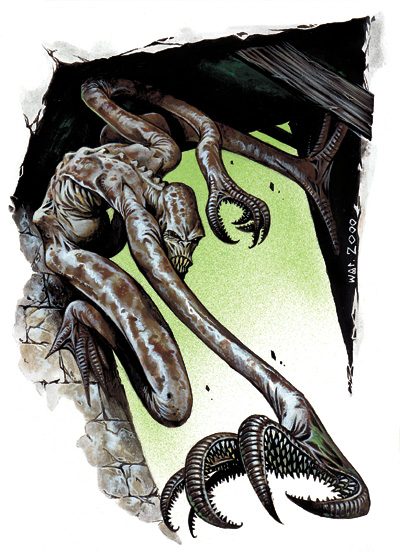 Small Aberration
Hit Dice: 3d8+3 (16 hp)
Initiative: +6
Speed: 20 ft. (4 squares), climb 10 ft.
Armor Class: 17 (+1 size, +2 Dex, +4 natural), touch 13, flat-footed 15
Base Attack/Grapple: +2/+5
Attack: Tentacle +6 melee (1d3+3)
Full Attack: 2 tentacles +6 melee (1d3+3)
Space/Reach: 5 ft./10 ft.
Special Attacks: Improved
grab, constrict 1d3+3
Special Qualities: Darkvision 60 ft., quickness
Saves: Fort +2, Ref +5, Will +4
Abilities: Str 16, Dex 14, Con 13, Int 4, Wis 13, Cha 7
Skills: Climb +13, Hide +10, Move Silently +6
Feats: Improved
InitiativeB, Lightning Reflexes,
Stealthy
Environment: Underground
Organization: Solitary
Challenge Rating: 2
Treasure: 1/10 coins; 50% goods; 50% items
Alignment: Usually chaotic evil
Advancement: 4–6 HD (Small); 7–12 HD (Medium)
Level Adjustment: —
Small Aberration
Hit Dice: 3d8+3 (16 hp)
Initiative: +6
Speed: 20 ft. (4 squares), climb 10 ft.
Armor Class: 17 (+1 size, +2 Dex, +4 natural), touch 13, flat-footed 15
Base Attack/Grapple: +2/+5
Attack: Tentacle +6 melee (1d3+3)
Full Attack: 2 tentacles +6 melee (1d3+3)
Space/Reach: 5 ft./10 ft.
Special Attacks: Improved
grab, constrict 1d3+3
Special Qualities: Darkvision 60 ft., quickness
Saves: Fort +2, Ref +5, Will +4
Abilities: Str 16, Dex 14, Con 13, Int 4, Wis 13, Cha 7
Skills: Climb +13, Hide +10, Move Silently +6
Feats: Improved
InitiativeB, Lightning Reflexes,
Stealthy
Environment: Underground
Organization: Solitary
Challenge Rating: 2
Treasure: 1/10 coins; 50% goods; 50% items
Alignment: Usually chaotic evil
Advancement: 4–6 HD (Small); 7–12 HD (Medium)
Level Adjustment: —
A creature perches in the shadows, near the ceiling, in a corner of the chamber. Its body resembles that of a naked halfling with mottled flesh, but its limbs are incredibly spindly and long. It hisses, showing sharp, large teeth an instant before one of its limbs snaps out like a whip.
These vicious little predators lurk underground, grabbing whatever prey happens by.
A choker’s skull, spine, and rib cage are bony, but its limbs are really tentacles with multiple knobby joints of cartilage. Thus, it appears bowlegged, and its movements seem peculiar and fluid. Its hands and feet have spiny pads that help the choker grip almost any surface. The creature weighs about 35 pounds.
Chokers speak Undercommon.
COMBAT
A choker likes to perch near the ceiling, often at intersections, archways, wells, or staircases, and reach down to attack its prey. A choker attacks creatures of almost any size, but prefers lone prey of its size or larger. If one is very hungry, it may attack a group, but it waits to grab the last creature in line.
Constrict (Ex): A choker deals 1d3+3 points of damage with a successful grapple check against a Large or smaller creature. Because it seizes its victim by the neck, a creature in the choker’s grasp cannot speak or cast spells with verbal components.
Improved Grab (Ex): To use this ability, a choker must hit a Large or smaller opponent with a tentacle attack. It can then attempt to start a grapple as a free action without provoking an attack of opportunity. If it wins the grapple check, it establishes a hold and can constrict. Chokers receive a +4 racial bonus on grapple checks, which is already included in the statistics block.
Quickness (Su): Although not particularly dexterous, a choker is supernaturally quick. It can take an extra standard action or move action during its turn each round.
Skills: A chokers has a +8 racial bonus on Climb checks and can always choose to take 10 on Climb checks, even if rushed or threatened.
CHUUL |
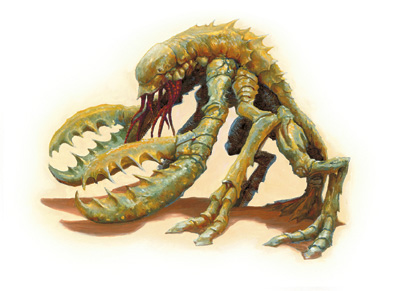 Large Aberration (Aquatic)
Hit Dice: 11d8+44 (93 hp)
Initiative: +7
Speed: 30 ft. (6 squares), swim 20 ft.
Armor Class: 22 (–1 size, +3 Dex, +10 natural), touch 12, flat-footed 19
Base Attack/Grapple: +8/+17
Attack: Claw +12 melee (2d6+5)
Full Attack: 2 claws +12 melee (2d6+5)
Space/Reach: 10 ft./5 ft.
Special Attacks: Constrict 3d6+5,
improved grab, paralytic tentacles
Special Qualities: Amphibious, darkvision 60 ft., immunity to poison
Saves: Fort +7, Ref +6, Will +9
Abilities: Str 20, Dex 16, Con 18, Int 10, Wis 14, Cha 5
Skills: Hide +13, Listen +11, Spot +11, Swim +13
Feats: Alertness, Blind-Fight, Combat Reflexes, Improved Initiative
Environment: Temperate marshes
Organization: Solitary, pair, or pack (3–5)
Challenge Rating: 7
Treasure: 1/10th coins; 50% goods; standard items
Alignment: Usually chaotic evil
Advancement: 12–16 HD (Large); 17–33 HD (Huge)
Level Adjustment: —
Large Aberration (Aquatic)
Hit Dice: 11d8+44 (93 hp)
Initiative: +7
Speed: 30 ft. (6 squares), swim 20 ft.
Armor Class: 22 (–1 size, +3 Dex, +10 natural), touch 12, flat-footed 19
Base Attack/Grapple: +8/+17
Attack: Claw +12 melee (2d6+5)
Full Attack: 2 claws +12 melee (2d6+5)
Space/Reach: 10 ft./5 ft.
Special Attacks: Constrict 3d6+5,
improved grab, paralytic tentacles
Special Qualities: Amphibious, darkvision 60 ft., immunity to poison
Saves: Fort +7, Ref +6, Will +9
Abilities: Str 20, Dex 16, Con 18, Int 10, Wis 14, Cha 5
Skills: Hide +13, Listen +11, Spot +11, Swim +13
Feats: Alertness, Blind-Fight, Combat Reflexes, Improved Initiative
Environment: Temperate marshes
Organization: Solitary, pair, or pack (3–5)
Challenge Rating: 7
Treasure: 1/10th coins; 50% goods; standard items
Alignment: Usually chaotic evil
Advancement: 12–16 HD (Large); 17–33 HD (Huge)
Level Adjustment: —
Like some large insect or monstrous crustacean, the creature rises from the still pool, its pincerlike claws snapping angrily as torchlight reflects off its mottled, armored carapace. Its small dark eyes fix you with a hungry stare, and the tentacles dripping from its mouth squirm excitedly as it emerges from the water.
A horrible mix of crustacean, insect, and serpent, the chuul is an abomination that lurks submerged or partially submerged, awaiting intelligent prey to devour.
Although amphibious, chuuls are not good swimmers and actually prefer to be on land or in very shallow water when they attack. They love to prey on lizardfolk.
Chuuls are known to collect trophies from their kills. Although unable to use weapons, armor, or most other belongings, chuuls keep these items in their lairs. If a victim has no interesting possessions, the chuul takes its skull.
Most chuuls live in swamps and jungles, but some have adapted to subterranean life, hunting in and near underground streams and lakes. These underground varieties often prey on troglodytes and unwary drow. They are sometimes found as thralls of beholders or mind flayers.
A chuul is about 8 feet long and weighs 650 pounds. Chuuls speak Common (or Undercommon, for the underground variety).
COMBAT
A chuul prefers to wait by the shore, submerged in murky water, until it hears nearby prey (in or out of the water) that it can attack with surprise. A chuul grabs with its claws and constricts its foe, then passes the opponent to its paralytic tentacles. It tries to always have one claw free, so if it faces a large number of opponents, it drops a paralyzed or dead victim and continues attempting to grab, constrict, and paralyze the rest.
Constrict (Ex): On a successful grapple check, a chuul deals 3d6+5 points of damage.
Improved Grab (Ex): To use this ability, a chuul must hit with a claw attack. It can then attempt to start a grapple as a free action without provoking an attack of opportunity. If it wins the grapple check, it establishes a hold and can constrict or on its next turn transfer a grabbed opponent to its tentacles.
Paralytic Tentacles (Ex): A chuul can transfer grabbed victims from a claw to its tentacles as a move action. The tentacles grapple with the same strength as the claw but deal no damage. However, they exude a paralytic secretion. Anyone held in the tentacles must succeed on a DC 19 Fortitude save each round on the chuul’s turn or be paralyzed for 6 rounds. The save DC is Constitution-based. While held in the tentacles, paralyzed or not, a victim automatically takes 1d8+2 points of damage each round from the creature’s mandibles.
Amphibious (Ex): Although chuuls are aquatic, they can survive indefinitely on land.
Skills: A chuul has a +8 racial bonus on any Swim check to perform some special action or avoid a hazard. It can always choose to take 10 on a Swim check, even if distracted or endangered. It can use the run action while swimming, provided it swims in a straight line.
CLOAKER |
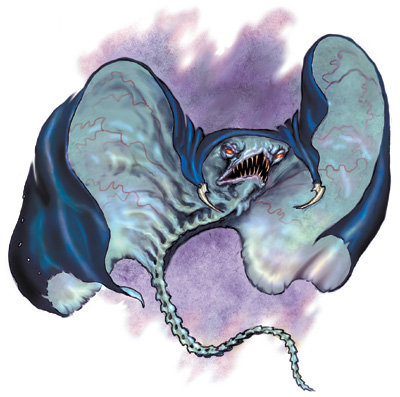 Large Aberration
Hit Dice: 6d8+18 (45 hp)
Initiative: +7
Speed: 10 ft. (2 squares), fly 40 ft. (average)
Armor Class: 19 (–1 size, +3 Dex, +7 natural), touch 12, flat-footed 16
Base Attack/Grapple: +4/+13
Attack: Tail slap +8 melee (1d6+5)
Full Attack: Tail slap +8 melee (1d6+5) and bite +3 melee (1d4+2)
Space/Reach: 10 ft./10 ft. (5 ft. with bite)
Special Attacks: Moan, engulf
Special Qualities: Darkvision 60 ft., shadow shift
Saves: Fort +5, Ref +5, Will +7
Abilities: Str 21, Dex 16, Con 17, Int 14, Wis 15, Cha 15
Skills: Hide +8, Listen +13, Move Silently +12, Spot
+13
Feats: Alertness, Combat Reflexes, Improved Initiative
Environment: Underground
Organization: Solitary, mob (3–6), or flock (7–12)
Challenge Rating: 5
Treasure: Standard
Alignment: Usually chaotic neutral
Advancement: 7–9 HD (Large); 10–18 HD (Huge)
Level Adjustment: —
Large Aberration
Hit Dice: 6d8+18 (45 hp)
Initiative: +7
Speed: 10 ft. (2 squares), fly 40 ft. (average)
Armor Class: 19 (–1 size, +3 Dex, +7 natural), touch 12, flat-footed 16
Base Attack/Grapple: +4/+13
Attack: Tail slap +8 melee (1d6+5)
Full Attack: Tail slap +8 melee (1d6+5) and bite +3 melee (1d4+2)
Space/Reach: 10 ft./10 ft. (5 ft. with bite)
Special Attacks: Moan, engulf
Special Qualities: Darkvision 60 ft., shadow shift
Saves: Fort +5, Ref +5, Will +7
Abilities: Str 21, Dex 16, Con 17, Int 14, Wis 15, Cha 15
Skills: Hide +8, Listen +13, Move Silently +12, Spot
+13
Feats: Alertness, Combat Reflexes, Improved Initiative
Environment: Underground
Organization: Solitary, mob (3–6), or flock (7–12)
Challenge Rating: 5
Treasure: Standard
Alignment: Usually chaotic neutral
Advancement: 7–9 HD (Large); 10–18 HD (Huge)
Level Adjustment: —
A long black cloak hangs from the cave wall. Suddenly, the cloak slips from the wall and catches a breeze moving through the cavern. Then it unfolds, the cloak becoming dark wings and a bony, whiplike tail unfurling to stretch out behind it. It flies forward, revealing a toothy maw and piercing red eyes deep in the shadows of its raylike body.
Cloakers are bizarre creatures that lurk in dark places far beneath the surface. They kill intruders without remorse or pause, except to plan cruel amusement.
When resting or lying in wait, these creatures are almost impossible to distinguish from common black cloaks (the cloaker’s ivory claws look very much like bone clasps). Only when it unfurls does the horrific nature of the creature become apparent.
Cloakers pursue their own mysterious goals. While they are certainly intelligent, their minds work in a way so alien that few humans have ever been able to make meaningful contact with one.
A cloaker has a wingspan of about 8 feet. It weighs about 100 pounds.
Cloakers speak Undercommon.
COMBAT
Cloakers usually lie still, watching and listening for prey. If facing a single opponent, a cloaker uses its engulf attack. Against multiple foes, it lashes with its tail in concert with its moan and shadow shift abilities to reduce the opposition’s numbers, then engulfs a survivor. Multiple cloakers usually split up, leaving one or two behind to use special abilities while the rest make melee attacks.
Moan (Ex): A cloaker can emit a dangerous subsonic moan as a standard action. By changing the frequency, the cloaker can cause one of four effects. Cloakers are immune to these sonic, mindaffecting attacks. Unless otherwise specified, a creature that successfully saves against one of these effects cannot be affected by the same moan effect from the same cloaker for 24 hours. All save DCs for moan effects are Charisma-based.
Unnerve: Anyone within a 60-foot spread automatically takes a –2 penalty on attack and damage rolls. Those forced to hear the moan for more than 6 consecutive rounds must succeed on a DC 15 Will save or enter a trance, unable to attack or defend themselves until the moaning stops.
Fear: Anyone within a 30-foot spread must succeed on a DC 15 Will save or become panicked for 2 rounds.
Nausea: Anyone in a 30-foot cone must succeed on a DC 15 Fortitude save or be overcome by nausea and weakness. Affected characters fall prone and become nauseated for 1d4+1 rounds.
Stupor: A single creature within 30 feet of the cloaker must succeed on a DC 15 Fortitude save or be affected as though by a hold monster spell for 5 rounds. Even after a successful save, the creature must repeat the save if the cloaker uses this effect again.
Engulf (Ex): A cloaker can try to wrap a Medium or smaller creature in its body as a standard action. The cloaker attempts a grapple that does not provoke an attack of opportunity. If it wins the grapple check, it establishes a hold and bites the engulfed victim with a +4 bonus on its attack roll. It can still use its whiplike tail to strike at other targets.
Attacks that hit an engulfing cloaker deal half their damage to the monster and half to the trapped victim.
Shadow Shift (Su): A cloaker can manipulate shadows. This ability is effective only in shadowy areas and has three possible effects.
Obscure Vision: The cloaker gains concealment (20% miss chance) for 1d4 rounds.
Dancing Images: This effect duplicates a mirror image spell (caster level 6th).
Silent Image: This effect duplicates a silent image spell (DC 15, caster level 6th). The save DC is Charisma-based.
COCKATRICE |
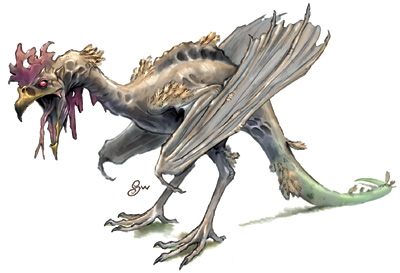 Small Magical Beast
Hit Dice: 5d10 (27 hp)
Initiative: +3
Speed: 20 ft. (4 squares), fly 60 ft. (poor)
Armor Class: 14 (+1 size, +3 Dex), touch 14, flat-footed 11
Base Attack/Grapple: +5/–1
Attack: Bite +9 melee (1d4–2 plus petrification)
Full Attack: Bite +9 melee (1d4–2 plus petrification)
Space/Reach: 5 ft./5 ft.
Special Attacks: Petrification
Special Qualities: Darkvision 60 ft., low-light vision
Saves: Fort +4, Ref +7, Will +2
Abilities: Str 6, Dex 17, Con 11, Int 2, Wis 13, Cha 9
Skills: Listen +7, Spot +7
Feats: Alertness, Dodge, Weapon FinesseB
Environment: Temperate plains
Organization: Solitary, pair, flight (3–5), or flock (6–13)
Challenge Rating: 3
Treasure: None
Alignment: Always neutral
Advancement: 6–8 HD (Small); 9–15 HD (Medium)
Level Adjustment: —
Small Magical Beast
Hit Dice: 5d10 (27 hp)
Initiative: +3
Speed: 20 ft. (4 squares), fly 60 ft. (poor)
Armor Class: 14 (+1 size, +3 Dex), touch 14, flat-footed 11
Base Attack/Grapple: +5/–1
Attack: Bite +9 melee (1d4–2 plus petrification)
Full Attack: Bite +9 melee (1d4–2 plus petrification)
Space/Reach: 5 ft./5 ft.
Special Attacks: Petrification
Special Qualities: Darkvision 60 ft., low-light vision
Saves: Fort +4, Ref +7, Will +2
Abilities: Str 6, Dex 17, Con 11, Int 2, Wis 13, Cha 9
Skills: Listen +7, Spot +7
Feats: Alertness, Dodge, Weapon FinesseB
Environment: Temperate plains
Organization: Solitary, pair, flight (3–5), or flock (6–13)
Challenge Rating: 3
Treasure: None
Alignment: Always neutral
Advancement: 6–8 HD (Small); 9–15 HD (Medium)
Level Adjustment: —
This avian creature is about the size of a large goose or turkey. It has the head and body of a cockerel, bat wings, and the long tail of a lizard. Its eyes glow with a dangerous-looking crimson sheen.
The cockatrice is an eerie, repulsive hybrid. It is infamous for its ability to turn flesh to stone.
A male cockatrice has wattles and a comb, just like a rooster. Females, much rarer than males, differ only in that they have no wattles or comb. A cockatrice weighs about 25 pounds.
COMBAT
A cockatrice fiercely attacks anything that it deems a threat to itself or its lair. Flocks of cockatrices do their utmost to overwhelm and confuse their foes, and sometimes fly directly into their opponents’ faces.
Petrification (Su): Creatures hit by a cockatrice’s bite attack must succeed on a DC 12 Fortitude save or instantly turn to stone. The save DC is Constitution-based. Cockatrices have immunity to the petrification ability of other cockatrices, but other petrification attacks affect them normally.
COUATL |
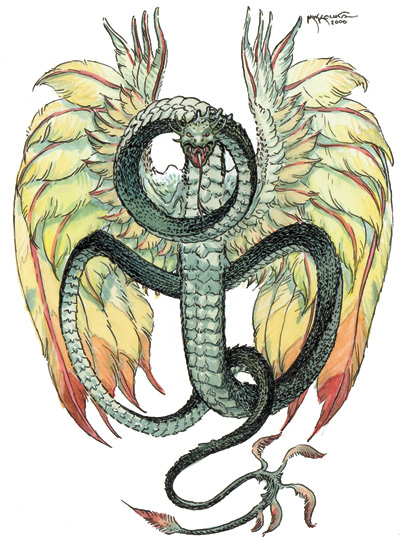 Large Outsider (Native)
Hit Dice: 9d8+18 (58 hp)
Initiative: +7
Speed: 20 ft. (4 squares), fly 60 ft. (good)
Armor Class: 21 (–1 size, +3 Dex, +9 natural), touch 12, flat-footed 18
Base Attack/Grapple: +9/+17
Attack: Bite +12 melee (1d3+6 plus poison)
Full Attack: Bite +12 melee (1d3+6 plus poison)
Space/Reach: 10 ft./5 ft.
Special Attacks: Constrict 2d8+6,
improved grab, poison, psionics, spells
Special Qualities: Darkvision 60 ft., ethereal jaunt, telepathy 90 ft.
Saves: Fort +8, Ref +9, Will +10
Abilities: Str 18, Dex 16, Con 14, Int 17, Wis 19, Cha 17
Skills: Concentration
+14, Diplomacy +17, Jump +0, Knowledge (any two) +15, Listen
+16, Search +15, Sense Motive +16, Spellcraft +15 (+17 scrolls), Spot +16, Survival +4 (+6 following tracks), Tumble +15, Use Magic
Device +15 (+17 scrolls)
Feats: Dodge, Empower Spell, Eschew MaterialsB, Hover, Improved Initiative
Environment: Warm forests
Organization: Solitary, pair, or flight (3–6)
Challenge Rating: 10
Treasure: Standard
Alignment: Always lawful good
Advancement: 10–13 HD (Large); 14–27 HD (Huge)
Level Adjustment: +7
Large Outsider (Native)
Hit Dice: 9d8+18 (58 hp)
Initiative: +7
Speed: 20 ft. (4 squares), fly 60 ft. (good)
Armor Class: 21 (–1 size, +3 Dex, +9 natural), touch 12, flat-footed 18
Base Attack/Grapple: +9/+17
Attack: Bite +12 melee (1d3+6 plus poison)
Full Attack: Bite +12 melee (1d3+6 plus poison)
Space/Reach: 10 ft./5 ft.
Special Attacks: Constrict 2d8+6,
improved grab, poison, psionics, spells
Special Qualities: Darkvision 60 ft., ethereal jaunt, telepathy 90 ft.
Saves: Fort +8, Ref +9, Will +10
Abilities: Str 18, Dex 16, Con 14, Int 17, Wis 19, Cha 17
Skills: Concentration
+14, Diplomacy +17, Jump +0, Knowledge (any two) +15, Listen
+16, Search +15, Sense Motive +16, Spellcraft +15 (+17 scrolls), Spot +16, Survival +4 (+6 following tracks), Tumble +15, Use Magic
Device +15 (+17 scrolls)
Feats: Dodge, Empower Spell, Eschew MaterialsB, Hover, Improved Initiative
Environment: Warm forests
Organization: Solitary, pair, or flight (3–6)
Challenge Rating: 10
Treasure: Standard
Alignment: Always lawful good
Advancement: 10–13 HD (Large); 14–27 HD (Huge)
Level Adjustment: +7
This great serpent with rainbow-feathered wings appears confident, powerful, and totally aware of everything around it.
The couatl is legendary for its sheer beauty, vast magical powers, and unwavering virtue. Its intelligence and goodness have made it an object of reverence in the regions it inhabits.
A couatl is about 12 feet long, with a wingspan of about 15 feet. It weighs about 1,800 pounds.
Couatls speak Celestial, Common, and Draconic, and also have the power of telepathy (see below).
COMBAT
A couatl uses its detect thoughts ability on any creature that arouses its suspicions. Since it is highly intelligent, a couatl usually casts spells from a distance before closing. If more than one couatl is involved, they discuss their strategy before a battle.
Change Shape (Su): A couatl can assume the form of any Small or Medium humanoid.
Constrict (Ex): A couatl deals 2d8+6 points of damage with a successful grapple check.
Improved Grab (Ex): To use this ability, a couatl must hit a creature of up to two size categories larger with its bite attack. It can then attempt to start a grapple as a free action without provoking an attack of opportunity. If it wins the grapple check, it establishes a hold and can constrict.
Poison (Ex): Injury, Fortitude DC 16, initial damage 2d4 Str, secondary damage 4d4 Str. The save DC is Constitution-based.
Psionics (Sp): Effective caster level 9th. The save DCs are Charisma-based.
At will —detect chaos, detect evil, detect good, detect law, detect thoughts (DC 15), invisibility, plane shift (DC 20)
Spells: A couatl casts spells as a 9th-level sorcerer. It can choose its spells known from the sorcerer list, the cleric list, and from the lists for the Air, Good, and Law domains. The cleric spells and domain spells are considered arcane spells for a couatl, meaning that the creature does not need a divine focus to cast them.
Typical Spells Known (6/7/7/7/4; save DC 13 + spell level):0 - cure minor wounds, daze, disrupt undead, light, obscuring mist, ray of frost, read magic, resistance;
1st - endure elements, mage armor, protection from chaos, true strike, wind wall;
2nd - cure moderate wounds, eagle’s splendor, scorching ray, silence;
3rd - gaseous form, magic circle against evil, summon monster III;
4th - charm monster, freedom of movement.
Ethereal Jaunt (Su): This ability works like the ethereal jaunt spell (caster level 16th).
Telepathy (Su): A couatl can communicate telepathically with any creature within 90 feet that has an Intelligence score. The creature can respond to the couatl if it wishes - no common language is needed.